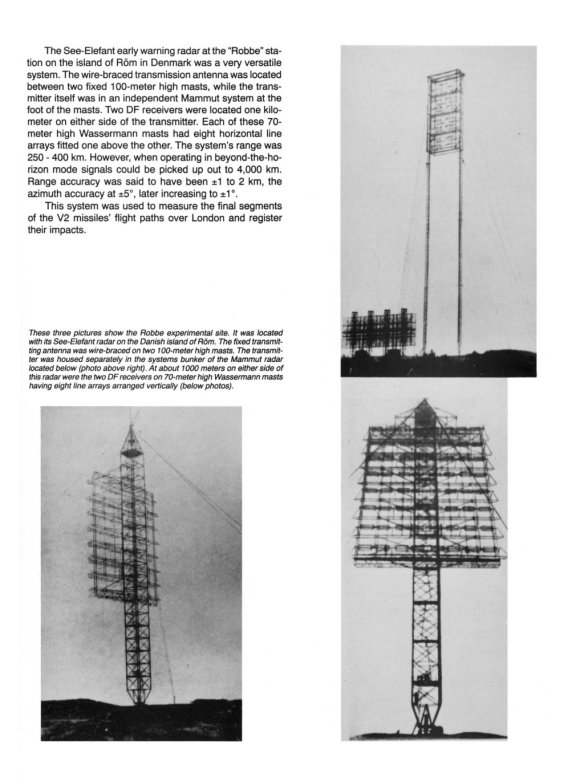The V-2 was immune from fighters and guns, although there was a plan for use of the latter that was never implemented. Attacking the locations for production and launching was the only immediate recourse, but after the Peenemünde raid of August 1943 production became dispersed and underground, and the launch sites were simpler than those of the V-1s and harder to destroy. Some results came from attacking train loads of the rockets, but the overall effect was not great. London and Antwerp simply had to take it.
Radar played an inconsequential role in this part of the play. Some CH stations were trained to watch for ascent of the rockets. The long wavelengths gave satisfactory reflections, but the accuracy was too poor for locating the insignificant launch sites. Coupled with tracking by specially altered gun-laying sets that gave last minute information about the descending phase, this brief warning had an important function. A hit on the Charing Cross river tunnel of the London Underground would have flooded the entire tube portion, almost certainly with great loss of life and serious disruption of economic and administrative functions. The tunnel was equipped with floodgates that were shut when the radar warning was received. Oddly enough a German copy of CH, Elefant-Rüssel, a few sets of which appeared late in the war, was used to help the engineers determine where the bombs fell. It was able to observe descent at a range of 800 km but with an accuracy of no use to either designers or users.
Elefant-Rüssel was an updated imitation of CH, built by the Reichspostzentralamt with Telefunken help. The reason for its introduction is to be found in the increasing chaos that marked the high levels of German radar direction late in the war and that led to many useless radar developments while ignoring the vital. There is no evidence that the Peenemünde group asked for it. The transmitter, Elefant, broadcast over 120° on the 10 to 15 m band from an array mounted on a high tower. The receiver, Rüssel (elephant’s trunk), was located about a kilometer away and differed from CH in using a high-gain steerable array for direction finding rather than pairs of crossed dipoles. Its range was less than Wassermann despite much greater power and direction was significantly worse, much as its CH counterpart. Very few were deployed, all of them along the coast.
There was an Elefant-Rüssel, the imitation of CH, at the Robbe Station. It was found to have about the same range capability as Wassermann and Mammut for bombers but was much worse for Mosquitoes; its receiver array had no lobe switching and was, of course much worse in directional accuracy than the two older sets.
A non-concentrated force of Mosquitoes flying without countermeasures at 7000 m was detected by Mammut and Wassermann at ranges in excess of 200 km only minutes after Y-Dienst reported their H2S emissions. Initial pick-up was for an individual aircraft; the estimate of the number in the formation became confused as more followed. The long-wave Elefant-Rüssel observed them first at only 50 km, a consequence of their wooden construction and Elefant’s long wavelength.
